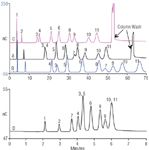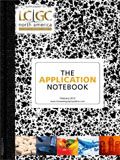Chromatoaphy Methods for Determining Carbohydrates in Coffee
The Application Notebook
Coffee carbohydrates constitute the major part (at least 50% of the dry weight) of raw coffee beans, and are good tracers for assessing the authenticity of instant coffee.
Coffee carbohydrates constitute the major part (at least 50% of the dry weight) of raw coffee beans, and are good tracers for assessing the authenticity of instant coffee.
Currently, the Association of Official Analytical Chemists (AOAC) Method 995.13 — which is based on high-performance anion-exchange chromatography with pulsed amperometric detection (HPAE-PAD) — is used to determine carbohydrates in instant coffee.
This study first tested Method 995.13 on a Thermo Scientific Dionex ICS-3000 system. A few modifications to the official method are proposed to achieve separation of two pairs of sugars that are otherwise difficult to resolve. A fast method using the Thermo Scientific Dionex CarboPac SA10 column was also tested.
Both methods described provide good sensitivity and consistent response. The fast method is recommended when rapid separation is desired, keeping in mind that two pairs of sugars are not resolved. In applications where all 11 common coffee carbohydrates need to be resolved, Method 995.13 (with minor modifications) is recommended.
Equipment
The experimental setup and the sample preparation procedures are described in Dionex Application Note 280 (now part of Thermo Fisher Scientific, Inc.).
Results
Figure 1A shows the separation of the carbohydrates present in a mix of standards. Rhamnose-arabinose and sucrose-xylose are not completely resolved. The official method suggests excluding rhamnose from the mixed standard solution and performing 2–3 injections of the standard solution, or increasing the re-equilibrium time in order to achieve separation of the above-mentioned pairs. As an alternative, the column temperature may be lowered (15 °C) to achieve separation of all 11 carbohydrates (Figure 1B), albeit with increased run time.

Figure 1
The first set of coeluting peaks (rhamnose and arabinose) was resolved by eluting with 10 mM hydroxide for the first 6 min, then switching to DI water (Figure 1C). Only the mobile phase was modified; all other chromatography conditions were the same as in Method 995.13.
Using the fast method, the mixture of coffee carbohydrate standards separated on a Dionex CarboPac™ SA10 column (Figure 1D) in 8 min. Note that two pairs of sugars coelute.
For both methods, precisions ranged from 0.13–1.8% for retention time, 1.05–5.4% for peak area, and 70-127% for the average recovery of the sugars.
Summary
Both methods are sensitive, accurate, reliable, and differ primarily in their total analysis time and peak resolutions for coffee carbohydrate determinations.
Scan to receive complete application note.
Thermo Fisher Scientific, Inc. (formerly Dionex Corp.)
1228 Titan Way, P.O. Box 3603, Sunnyvale, CA 94088
tel. (408) 737-0700, fax (408) 730-9403
Website: www.thermoscientific.com/dionex

Analytical Challenges in Measuring Migration from Food Contact Materials
November 2nd 2015Food contact materials contain low molecular weight additives and processing aids which can migrate into foods leading to trace levels of contamination. Food safety is ensured through regulations, comprising compositional controls and migration limits, which present a significant analytical challenge to the food industry to ensure compliance and demonstrate due diligence. Of the various analytical approaches, LC-MS/MS has proved to be an essential tool in monitoring migration of target compounds into foods, and more sophisticated approaches such as LC-high resolution MS (Orbitrap) are being increasingly used for untargeted analysis to monitor non-intentionally added substances. This podcast will provide an overview to this area, illustrated with various applications showing current approaches being employed.

















